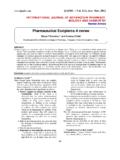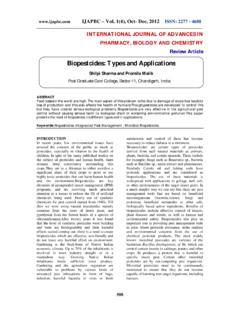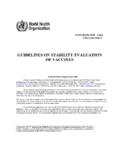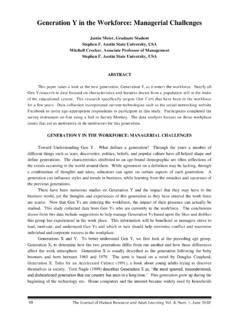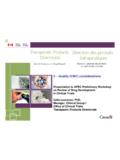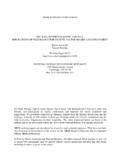Transcription of Analytical Method Validation: An Updated Review
1 IJAPBC Vol. 1(1), Jan- Mar, 2012 _____ 64 INTERNATIONAL JOURNAL OF ADVANCES IN PHARMACY, BIOLOGY AND CHEMISTRY Review Article ABSTRACT The development of sound Analytical Method (s) is of supreme importance during the process of drug discovery, release to market and development, culminating in a marketing approval. The objective of this paper is to Review the Method development, optimize and validation of the Method for the drug product from the developmental stage of the formulation to commercial batch of the product. Method development for the interested component in finished product or in process tests and the sample preparation of drug product and to provide practical approaches for determining selectivity, specificity, limit of detection, limit of quantitation, linearity, range accuracy, precision, recovery solution stability, ruggedness, and robustness of liquid chromatographic methods to support the Routine, in process and stability analysis.
2 Keyw ords: Analytical Method development, validation parameters, acceptance criteria. INTRODUCTION The reliability of an Analytical finding is a matter of great importance to drive the formulation scientist in the developmental stage and impurity profile in stability study and dissolution data of the stability study as well as routine analysis. The importance of validation is producing reliable and repeatable results for routine analysis and stability analysis. This is especially true in the context of quality management and accreditation, which have become matters of increasing importance in Analytical in dissolution and impurity profile in the recent years.
3 Therefore, this topic should extensively be discussed on an international level to reach an accord on the extent of validation experiments and on acceptance criteria for validation parameters of Analytical methods1. NEED OF Analytical Method VALIDATION It is essential to employ well-characterized and fully validated Analytical methods to yield reliable results in the laboratories while analysing the registration batch and accelerated stability testing samples. It is also important to emphasize that each Analytical technique has its own characteristics, which will vary from analyte to analyte. In these instances, specific validation criteria may need to be developed for each analyte.
4 Moreover, the appropriateness of the technique may also be influenced by the ultimate objective of the study. When sample analysis for a given study is conducted at more than one site and commercial batch for people consumption, it is necessary to validate the Analytical Method (s) as per ICH guidelines and to provide proper validation information for different sites and different parameter and to establish inter and intra laboratory reliabilitY2. Analytical Method DEVELOPMENT AND VALIDATION Analytical Method development is the process by which a specific Analytical Method is to be developed for drug products from the stage of in process to finished product and minivalidation to be done before starting the analyses of routine samples, investigation samples and stability samples.
5 Analytical Method development and Analytical Method Validation: An Updated Review G. Geetha, Karanam Naga Ganika Raju, B. Vignesh Kumar and M. Gnana Raja* Sankaralingam Bhuvaneswari College of Pharmacy, Annaikuttam, Virudhunagar District, Tamil Nadu, India. IJAPBC Vol. 1(1), Jan- Mar, 2012 _____ 65 finalizing the Method consists of 1. Standardizing the working standard from reference standard. 2. Optimizing the chromatographic condition, concentration of standard and sample solution and extraction procedure of the sample. 3. Analytical Method verification or mini validation to be done before analysing (routine samples) tests like assay, dissolution and related substance in development laboratories etc.
6 4. Prior starting the validation the satisfactory result should be found in mini validation and formulation should be finalized3. TERMINOLOGY Validation It is accepted that during the course of a typical drug product development program, a defined Analytical Method will undergo many modifications because composition changes, lower strength may be added or percentage of coating material may change on the formulation. Because of the changes the Analytical Method may be modified and if modified it should be verified so it requires different levels of validation. Two different levels/types of Method validations, complete validation and partial validation or mini, validation, are defined and characterized as follows.
7 Complete validation Complete validation is necessary before executing clinical batch or registration batch of drug product. If any modification in the formulation or if any impurity found in the stability study the existing Method to be modified and validated again, and the parameters are detailed below for the complete validation given table 1. Mini validation Mini validations is required for all the test methods like Assay, Related substance, UOD and Blend Uniformity for analysing the routine samples prior starting the complete validation some parameters to be checked as per ICH Guidelines detailed below given table 2 and acceptance criteria discuss later4.
8 VALIDATION PARAMETERS Linearity A linear relationship should establish across the range as per table 3 given below. It may be demonstrated directly on the active substance by linear dilution and percentage level of each parameter given below table 3. The linear range of the Method must be determined regardless of the all stage of the formulation during drug development. ICH guidelines recommend evaluating a minimum of five concentrations to assess linearity and wider range of concentration and other approaches should be justified. The correlation coefficient, Y-intercept, Slope of the regression line and residual sum of square shall be submitted by appropriate statistical Method [5].
9 The linearity solutions are prepared by performing serial dilutions of a single stock solution, for related substance, residual solvent impurity blend or solvent blend shall be used. The response of the interested peak is plotted against the, corresponding theoretical concentration. For related substance Method relative response factors and relative retention times for each impurity should establish with respect to the active compound. Response factors allow the end user to not using the impurity material for each analysis, and it is useful to correcting for response differences and final impurity calculation. To determine the relative response factors, linearity curve Method or about and percent for each impurity and the active compound should be injected and find the relative response factor from the slope of the linearity curve or ratio between the response factor of impurity and response factor of active compound6.
10 Selectivity (Specificity) For clinical and before registration batch of the drug product, the Analytical Method must demonstrate specificity including degradation study. The Method must have the ability to separate each known impurity and degradation product at the quantitation level and if any blank, placebo peaks are found it should be properly separated from impurity peak and interested peak. For identification tests, discrimination of the Method should be demonstrated by obtaining positive results for samples containing the analyte and negative results for samples not containing the analyte. The Method must be able to differentiate between the analyte of interest and compounds with a similar chemical structure that may be present.
